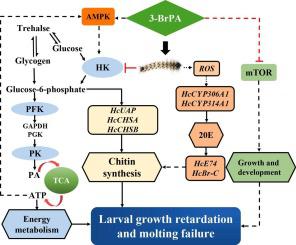Pesticide Biochemistry and Physiology ( IF 4.2 ) Pub Date : 2021-08-30 , DOI: 10.1016/j.pestbp.2021.104961 Qian Qiu 1 , Haifeng Zou 1 , Hang Zou 1 , Tianzhong Jing 1 , XingPeng Li 2 , Gaige Yan 1 , Nannan Geng 1 , Bihan Zhang 1 , Zhidong Zhang 1 , Shengyu Zhang 1 , Bin Yao 1 , Guocai Zhang 1 , Chuanshan Zou 1

|
As a typical glycolytic inhibitor, 3-bromopyruvate (3-BrPA) has been extensively studied in cancer therapy in recent decades. However, few studies focused on 3-BrPA in regulating the growth and development of insects, and the relationship and regulatory mechanism between glycolysis and chitin biosynthesis remain largely unknown. The Hyphantria cunea, named fall webworm, is a notorious defoliator, which caused a huge economic loss to agriculture and forestry. Here, we investigated the effects of 3-BrPA on the growth and development, glycolysis, carbohydrate homeostasis, as well as chitin synthesis in H. cunea larvae. To elucidate the action mechanism of 3-BrPA on H. cunea will provide a new insight for the control of this pest. The results showed that 3-BrPA dramatically restrained the growth and development of H. cunea larvae and resulted in larval lethality. Meanwhile, we confirmed that 3-BrPA caused a significant decrease in carbohydrate, adenosine triphosphate (ATP), pyruvic acid (PA), and triglyceride (TG) levels by inhibiting glycolysis in H. cunea larvae. Further studies indicated that 3-BrPA significantly affected the activities of hexokinase (HK), phosphofructokinase (PFK), pyruvate kinase (PK), glucose 6-phosphate dehydrogenase (G6PDH) and trehalase, as well as expressions of the genes related to glycolysis, resulting in carbohydrate homeostasis disorder. Moreover, it was found that 3-BrPA enhanced 20-hydroxyecdysone (20E) signaling by upregulating HcCYP306A1 and HcCYP314A1, two critical genes in 20E synthesis pathway, and accelerated chitin synthesis by upregulating transcriptional levels of genes in the chitin synthesis pathway in H. cunea larvae. Taken together, our findings provide a novel insight into the mechanism of glycolytic inhibitor in regulating the growth and development of insects, and lay a foundation for the potential application of glycolytic inhibitors in pest control as well.
中文翻译:

3-溴丙酮酸诱导的糖酵解抑制影响秋季蛔虫幼虫的生长发育和碳水化合物稳态,Hyphantria cunea Drury
作为典型的糖酵解抑制剂,3-溴丙酮酸 (3-BrPA) 近几十年来在癌症治疗中得到了广泛的研究。然而,很少有研究关注3-BrPA对昆虫生长发育的调控,糖酵解与几丁质生物合成之间的关系和调控机制在很大程度上仍不清楚。在美国白蛾,命名为美国白蛾,是一个臭名昭著的叶器,这造成了巨大的经济损失,对农业和林业。在这里,我们研究了 3-BrPA 对H. cunea幼虫的生长发育、糖酵解、碳水化合物稳态以及几丁质合成的影响。阐明 3-BrPA 对H. cunea的作用机制将为防治这种害虫提供新的思路。结果显示,3-BrPA抑制显着的成长和发展H.美国白蛾幼虫导致幼虫的杀伤力。同时,我们证实 3-BrPA 通过抑制H. cunea 的糖酵解导致碳水化合物、三磷酸腺苷 (ATP)、丙酮酸 (PA) 和甘油三酯 (TG) 水平的显着降低幼虫。进一步研究表明,3-BrPA显着影响己糖激酶(HK)、磷酸果糖激酶(PFK)、丙酮酸激酶(PK)、葡萄糖6-磷酸脱氢酶(G6PDH)和海藻糖酶的活性,以及糖酵解相关基因的表达,导致碳水化合物稳态失调。此外,人们发现,3- BrPA增强20-羟基(20E)通过上调信令HcCYP306A1和HcCYP314A1在20E合成途径,两个关键基因,并通过在几丁质合成途径上调的基因的转录水平加速几丁质合成H.美国白蛾幼虫。总之,我们的研究结果为糖酵解抑制剂调节昆虫生长发育的机制提供了新的见解,也为糖酵解抑制剂在害虫防治中的潜在应用奠定了基础。











































 京公网安备 11010802027423号
京公网安备 11010802027423号